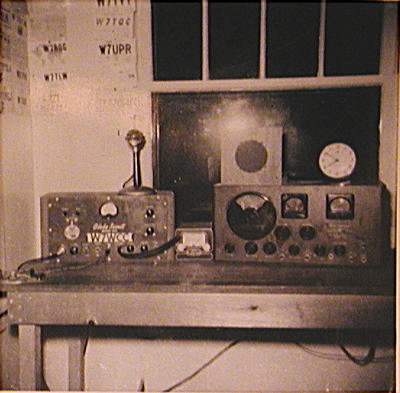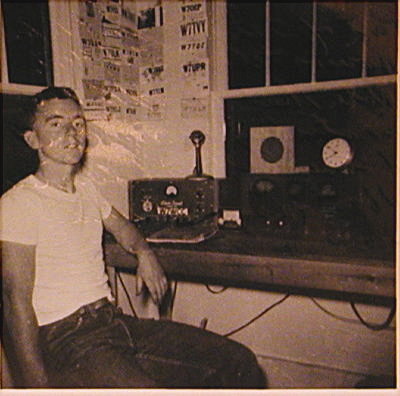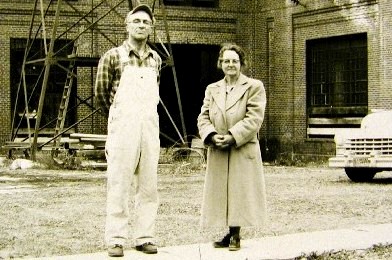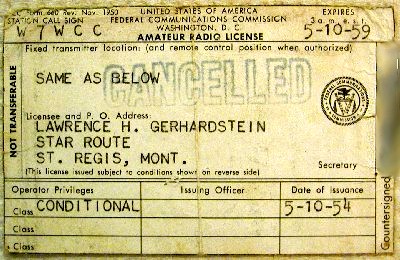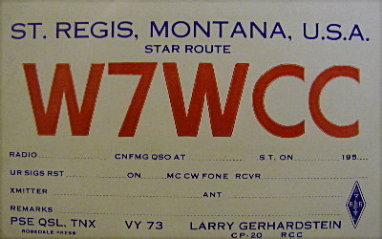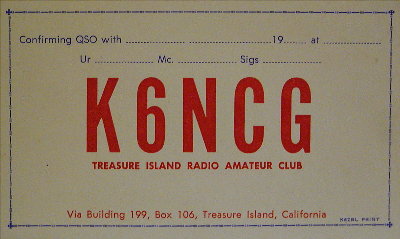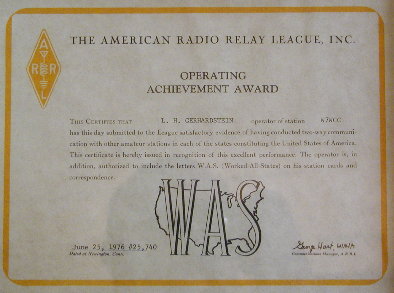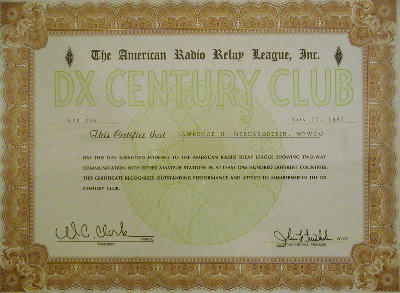73 DE
W7IN / W7WCC
Last updated 27 November 2008
Greetings,
I am Larry
Gerhardstein of Plains,
It started
while in high school at St. Regis, Montana. Sometime about 5th or 6th
grade, I discovered my father's short wave radio receiver and got hooked by the
sounds of far away ham and broadcast stations. At the time, Radio Moscow
and Radio America were the best we could receive. So on 10 May 1954, at
age 14, I became a licensed amateur radio operator, receiving the call sign
W7WCC from the FCC. During the time I studied for my FCC amateur radio
examinations, my mentors were Carl Mienke, W7TQC, and
Bill Clark, W7VUF. Both were Milwaukee Railroad electric substation
operators, and worked with my father at Drexel Substation, 8 miles west of
My father
Carl Gerhardstein, though a very capable electronics technician and electrical
distribution operator, never became a licensed ham. So to get started,
Bill Clark and I sent and copied Morse code together every evening, about 2-3
hours, for about 4-5 weeks. That practice helped us master the code,
enabling both of us to take and pass the FCC 13 word per minute receiving and
sending examinations.
My first ham
station consisted of a WRL Globe Scout model 40A transmitter (kit), Lysco VFO, Hallicrafter's SX-25
receiver (WW-II vintage), military surplus J-38 telegraph key, balun coil, and a Windom antenna (See photos below).
Due to a wiring diagram error in the Globe Scout assembly instructions, along
with a defective tank coil, it took a few days to get my transmitter working
properly. Fortunately, my mentor W7TQC came to my rescue and we finally
got my station on the air. In addition to encouragement from my ham radio
Elmers, I got plenty of thoughtful prodding from my
father, who was anxious to see me enter into an electronics and engineering
career.
My first ever
QSO on amateur radio was with well known XYL ham Clarice Goodman, W7FTX,
Hamilton, Montana on 3980 KHz in the 75 meter AM phone band, at 11:10 p.m. MST
on 20 June 1954. Though my first QSO was on AM phone, I later became an
avid CW (Morse code) operator. I loved sending code with a straight key,
prior to suffering a severe injury to my sending hand and right arm about 10
years ago. Back then, several hams told me that I had one of the best
straight key fists they had ever heard. I eventually graduated to an electronic
keyer and SSB.
Operating ham
radio from Drexel Substation proved difficult. Anyone who has driven past
Drexel, exit 25, on I-90 knows that QTH is deep inside a narrow gorge.
Shadowed by Boyd Mtn. to the north, Ward Mtn. to the east, and Moon Pk. to
the south, that fact made successful QSOs on 10, 15,
and 20 impossible. During the time I operated from Drexel, I had only one
successful QSO on 20 Meters, via E-Layer to Alaska. Then consider that
our house sat directly under a 110,000 volt Montana
Power Company transmission line, most of the time QRN was horrendous. So
until we moved from Drexel Substation, I never worked any real DX.
None-the-less, ham radio was possible in a limited way, given that both 80 and
40 Meter bands, at times, offer friendly high angle propogation.
I tried 160 Meters, but the 110KV line QRN won that battle every time.
One of my
more memorable experiences regarding ham radio occurred during my 6 month stay
at Treasure Island, California while in the U.S. Navy. During that time,
I served as an operator for the U.S. Navy Special Services K6NCG amateur radio station. In
1958, a K6NCG operator's duties included checking into California and San
Francisco Bay Area traffic nets, and negotiating phone patches for sailors and
marines returning from off-shore tours of duty. During our spare time, we
worked DX, very plentiful in 1958 at the height of the greatest sun spot cycle
ever. As did many ham operators from this area, after the May 1980 eruption
of Mount Saint Helen's in Western Washington, I helped pass health and welfare
traffic into and out of the affected area both on 2 Meters and 80 Meters.
In about
1983, I successfully qualified for DX
Century Club (DXCC #24,436) by working and QSL-ing
amateur radio station contacts in 100 countries. My 100 countries were
worked entirely with medium power and wire antennas (i.e., dipole, Windom,
folded dipole, Bazooka, random length wire, to name a few)
I also have Worked All States
(WAS #25,740), Bicentennial WAS (#840), and a few minor operator awards.
I am a member
of ARRL -- American Radio Relay League, QCWA -- Quarter Century Wireless Association
(#19594), ROWH -- The
Royal Order of the Wouff Hong, 10-10 -- Ten-Ten International Net (#17433),
AMSAT Radio Amateur Satellite Corporation
(#36787), and MARAC Mobile Amateur Radio Awards
Club (R-4314). I support and encourage the use of all our
frequencies, including bands less populated during low sunspot activity, e.g.
10 Meters and 6 Meters. The new digital communication modes sound very
exciting and I hope to try them out very soon.
It has given
me great pleasure to help a couple of CB'ers graduate
into the ham ranks. Among those is my good friend Kent Stewart, KA7GKW, who has now learned so
much about ham radio and computers, he has helped me out a lot. While
Kent was working 11 Meter skip to Alaska, I logged world wide DX on the h.f. ham bands, and would come into work with a long list
of exotic call signs I had logged the night before. Kent could not stand
the pressure, so he finally learned Morse code and earned his ham
license. With a little encouragement from hams, I think more CB'ers would leave 11 meters to the jammers
and come join our ranks.
As for my
first ham radio mentors, C. William (Bill) Clark became a silent key (SK)
Clarice
Goodman became a SK in 1997. I had communicated with Clarice on 2 Meter
FM while driving through Missoula on I-90 not long before that. First
licensed in 1935, Clarice had over 60 years in ham radio. Her call sign
has been reassigned to the Bitterroot Amateur Radio Club, Stevensville,
Montana. Read about W7FTX,
Clarice Goodman's noteworthy ham radio career at QRZ.COM.
My first ham
friend Carl H Mienke, after retiring from Bonneville
Power Administration (BPA), moved from Anaconda, Montana to Okeechobee,
Florida. Years before that, on New Year's Eve 1957, while on boot camp
leave from the U.S. Navy, I contacted W7TQC on 40 Meter AM and made an entry in
my log. I do not know that I ever met Carl on the radio airwaves after
that. He became a SK in 1993, age 76. Carl's W7TQC QSL card from
our first contact in
A FEW FACTS
Employed at: Pacific Northwest National Laboratory (PNNL),
E-Mail
addresses: w7in(at)qsl.net, larry(at)3-cities.com.
Packet
address: [CHECK BACK LATER]
Echolink node: 67614
License
class: Amateur Extra
Grid
location: DN06ke
Coordinates:
N46.1781 W119.0910 (WGS84)
Web
addresses: http://www.qsl.net/w7wcc/, http://users.amerion.com/larryg/, http://gerhardstein.org/
You are visitor number
since
PHOTOGRAPHS
|
|
|
|
Ham Radio Station W7WCC,
1954-1955. WRL Globe Scout, Lysco VFO, J-38,
and Hallicrafters SX-25. We suspended my
Windom antenna across the |
Me, age 16, at W7WCC operating
position. |
|
|
|
|
My parents, Carl & Marjorie Gerhardstein, at East Portal Substation, fall 1955. Note the 1947 Cadillac, the car in which I learned to drive. |
My first ham license. Though I had not yet operated, when my license arrived, I recognized immediately W7WCC would be a great CW callsign. |
|
|
|
|
QSL card that I used during
1954-57 at |
QSL card in use at K6NCG, |
|
|
|
|
WAS Award #25,740, |
DXCC Award #24,436, |
Thanks
to QSL.NET for hosting this site.
